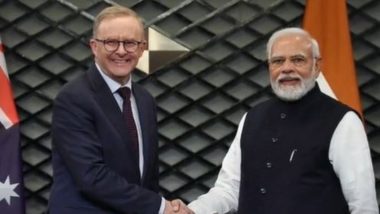New Delhi, November 30: The free trade agreement between India and Australia will come into force from December 29 giving duty free access to thousands of domestic goods in that market, which will help in almost doubling the bilateral commerce to USD 45-50 billion in around five years.
The Economic Cooperation and Trade Agreement (ECTA), which was signed on April 2, would provide duty-free access to Indian exporters of over 6,000 broad sectors, including textiles, leather, furniture, jewellery and machinery in the Australian market.
Labour-intensive sectors which would gain immensely include textiles and apparel, few agricultural and fish products, leather, footwear, furniture, sports goods, jewellery, machinery, and electrical goods. Commerce and industry minister Piyush Goyal said the trade pact will come into effect from December 29 this year.
"India and Australia consolidate their long-standing partnership. ECTA, realised under the guidance of leaders on both countries, comes into effect from December 29, 2022. It is the dawn of a whole new era for our businesses and people." Goyal said in a tweet on Wednesday.
Both the countries have completed their domestic requirements to enable implementation of the ECTA. In a statement, Australian Minister for Trade and Tourism Don Farrell said: "The ECTA's two tariff cuts in quick succession intensify the up-front benefits of this agreement for our exporters".
Under the pact, Australia is offering zero-duty access to India for about 96.4 per cent of exports (by value) from day one. This covers many products that currently attract 4-5 per cent customs duty in Australia. Industry Bodies Hail India-Australia Free Trade Deal.
India's goods exports to Australia stood at USD 8.3 billion and imports from the country aggregated to USD 16.75 billion in 2021-22. The statement said that from 29 December, tariffs on 85 per cent of Australia's exports to India will be eliminated and high tariffs on a further 5 per cent of goods will be phased down.
"Entry into force of the agreement before the New Year delivers a double bonus of two tariff cuts in quick succession: one as the agreement comes into effect and a second on 1 January 2023," it said. It added that ECTA will save Australian exporters around USD 2 billion a year in tariffs, while consumers and businesses will save around USD 500 million in tariffs on imports of finished goods, and inputs to "our manufacturing sector".
The tariff commitments provided by India in the agreement will open up access for Australia's exporters of products including critical minerals, pharmaceuticals, cosmetics, lentils, seafood, sheepmeat, horticulture and wine, it said.
Further, it said that Australian service suppliers will benefit from full or partial access across more than 85 Indian services sectors and subsectors. Australian suppliers across 31 sectors and subsectors will be guaranteed the highest standard of treatment that India grants to any future free trade agreement partner.
ECTA will also support tourism and workforce needs in regional Australia by making 1,000 work and holiday programme places available to young Indians, it said adding the pact maintains opportunities for Indian students graduating in Australia to undertake post-study work, with a bonus year of stay for high-performing STEM (science, technology, engineering, or mathematics) graduates.
The statement also said that both the countries are now progressing a comprehensive economic cooperation agreement to build on ECTA. "The Australian Government is pursuing further opportunities in goods and services, in addition to new commitments in areas such as digital trade, government procurement, and new areas of cooperation," it added.
Australian Prime Minister Anthony Albanese said that the agreement is the next step in elevating our relationship with India, the world's fastest growing large economy. "Austrade can assist existing and potential exporters benefit from the lowering of trade barriers into the Indian market," Farrell said.
Commenting on the development, Gems and Jewellery Export Promotion Council (GJEPC) said that the pact would help boost bilateral gems and jewellery trade to USD 2 billion.
In 2021-22, the bilateral trade in the sector was USD 1.3 billion. Key commodities exported to Australia are plain gold jewellery, studded jewellery and cut & polished diamonds. The main commodities imported from Australia are precious metals - gold and silver bars.
India's gems and jewellery exports to Australia grew 21 per cent to USD 183.86 million during April–October 2022. "We expect Australia to benefit from access to areas where India is a world leader, such as diamonds. Australia is one of our large suppliers of gold bullion, and until recently, it was also a key supplier of diamonds," it added.













 Quickly
Quickly




















